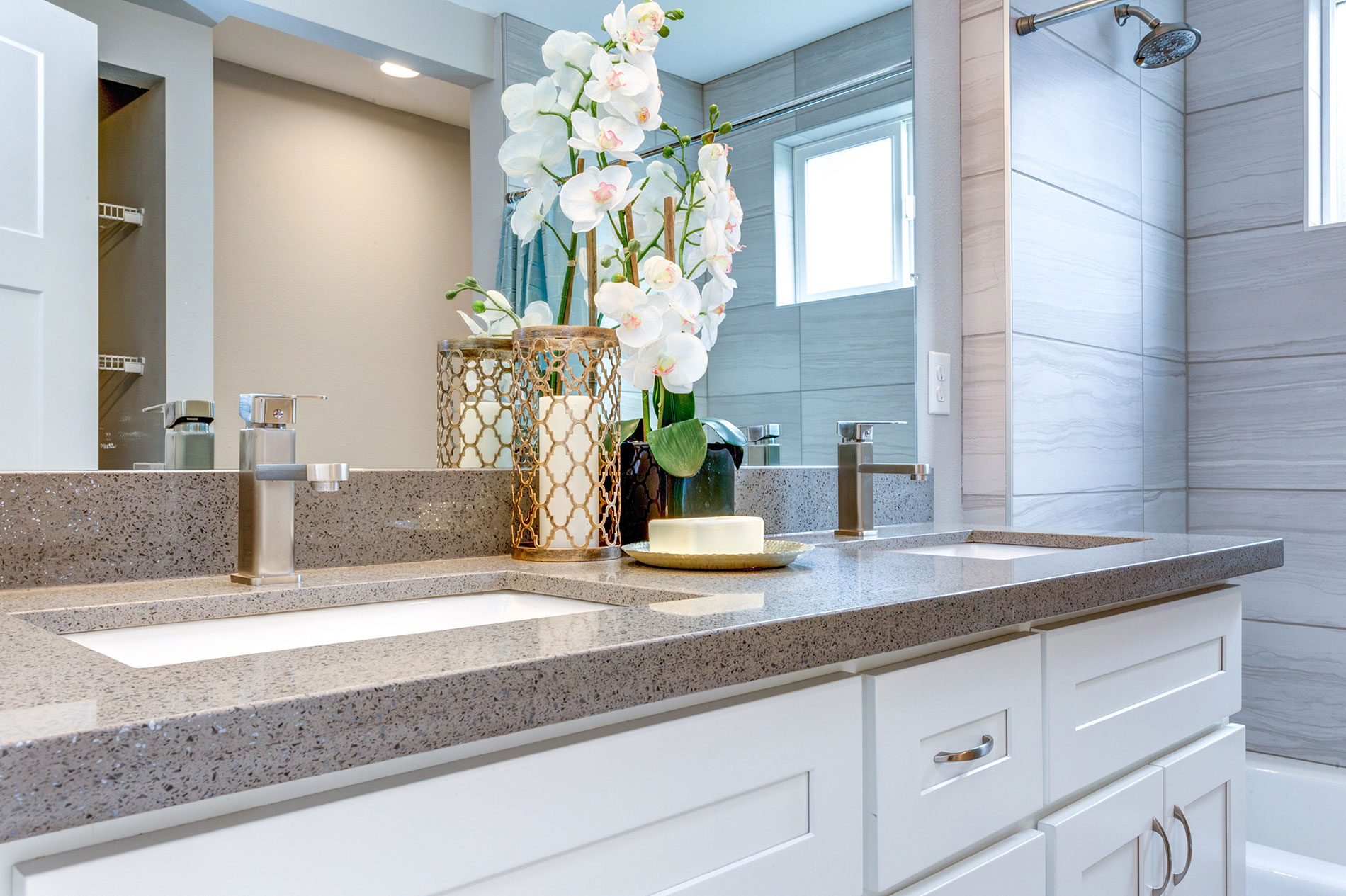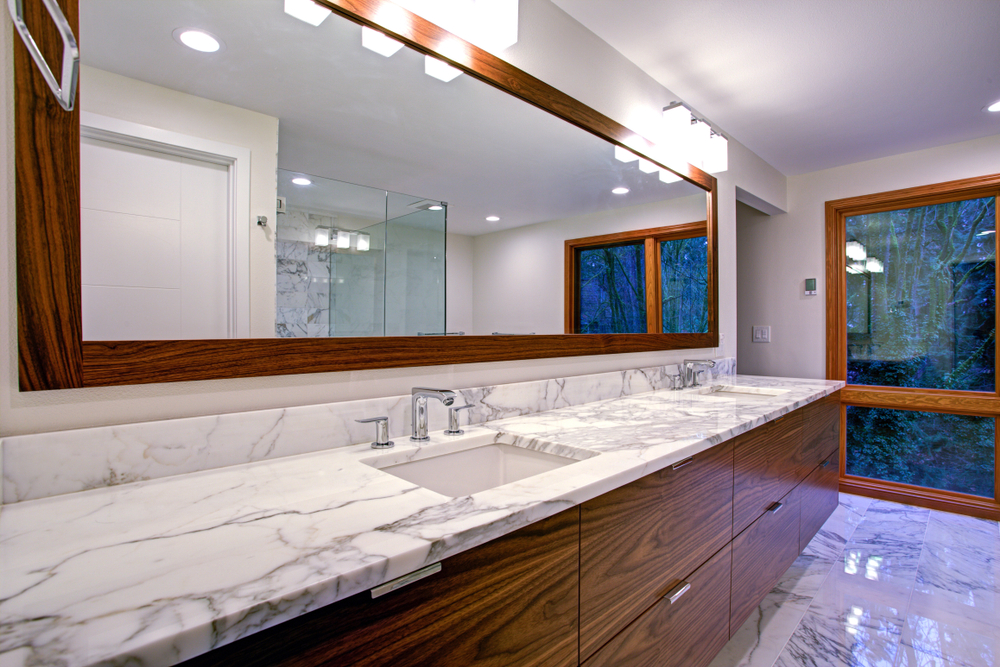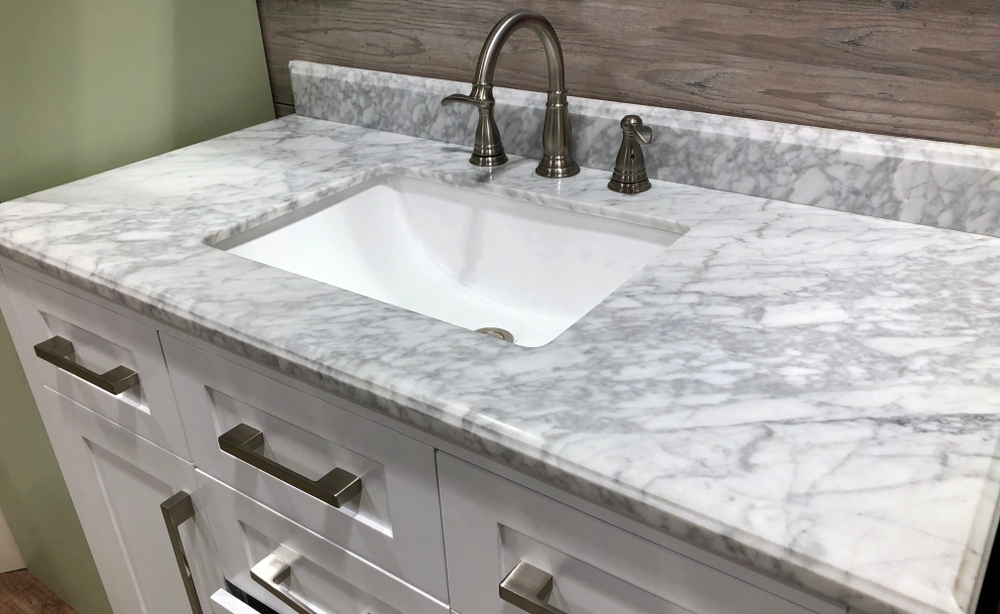Marble’s Advantages for Bathroom Countertops

Marble is a popular choice for bathroom countertops due to its elegance and durability. Its timeless appeal and natural beauty can elevate any bathroom design.
Durability in a Bathroom Environment
Marble is a natural stone that is known for its durability. However, it’s essential to understand that marble is porous and susceptible to staining and etching. While it can withstand daily wear and tear, it requires proper care and maintenance to preserve its beauty.
Aesthetic Appeal of Marble
Marble’s natural beauty is one of its most significant advantages. Each slab of marble is unique, showcasing distinctive veining patterns and color variations. This natural variation adds character and depth to any bathroom design. From classic white marble with subtle grey veining to dramatic black marble with bold white streaks, the options are endless.
Ease of Cleaning and Maintenance
Marble countertops are relatively easy to clean and maintain. Regular cleaning with a mild detergent and a soft cloth is sufficient to remove dirt and grime. However, acidic cleaners should be avoided as they can damage the surface. It’s also important to seal marble countertops regularly to protect them from stains and etching.
Heat Resistance of Marble, Is marble good for bathroom countertops
While marble is a relatively heat-resistant material, it’s not completely impervious to heat damage. Placing hot items directly on the countertop can cause discoloration or cracking. It’s advisable to use trivets or hot pads to protect the surface.
Marble’s Disadvantages for Bathroom Countertops

Marble, despite its undeniable beauty and elegance, comes with certain disadvantages that homeowners should carefully consider before making a decision. While its aesthetic appeal is undeniable, its susceptibility to staining, etching, scratches, and the need for regular maintenance can make it a high-maintenance option for some.
Potential for Staining and Etching
Marble is a porous stone, meaning it has tiny holes that can absorb liquids. This porosity makes it vulnerable to staining from acidic substances like wine, juice, coffee, and even some cleaning products. When acidic substances come into contact with marble, they can react with the calcium carbonate in the stone, causing etching, which appears as dull, cloudy spots on the surface.
Choosing and Caring for Marble Countertops: Is Marble Good For Bathroom Countertops

Choosing the right marble for your bathroom countertops involves considering various factors, including the type of marble, its color and pattern, and the desired finish. Understanding these aspects will help you make an informed decision and ensure your countertops are both aesthetically pleasing and durable.
Marble Types Suitable for Bathroom Countertops
Marble is a natural stone with variations in color, pattern, and durability. Some marble types are better suited for bathroom countertops due to their resistance to moisture and stains. Popular choices include:
- Carrara Marble: Known for its white background with gray veining, Carrara marble is a classic choice for bathroom countertops. It’s relatively affordable and offers a timeless elegance.
- Calacatta Marble: Similar to Carrara marble but with bolder, more dramatic veining, Calacatta marble adds a luxurious touch to any bathroom. It’s known for its white background with gray, gold, or brown veins.
- Statuary Marble: Renowned for its pristine white background and subtle, delicate veining, Statuary marble exudes a sense of sophistication and refinement. It’s often used in high-end bathrooms.
- Crema Marfil Marble: This marble features a warm, creamy background with subtle veining in shades of brown, gray, or beige. It offers a softer, more inviting look compared to other white marbles.
- Emperador Marble: With its rich, dark brown background and dramatic veining, Emperador marble creates a bold statement in bathroom design. It’s a popular choice for adding a touch of luxury and sophistication.
Selecting Marble Color and Pattern for Bathroom Design
The color and pattern of your marble countertops should complement your bathroom’s overall design. Consider the following factors:
- Bathroom Style: A modern bathroom might benefit from a minimalist marble with subtle veining, while a traditional bathroom could embrace a bolder pattern with intricate veining.
- Lighting: The lighting in your bathroom will affect how the marble color and pattern appear. A brightly lit bathroom can handle darker marbles, while a dimly lit space might benefit from lighter marbles with less veining.
- Existing Color Palette: Choose a marble color and pattern that complements the existing color palette of your bathroom. For instance, a marble with warm tones can enhance a bathroom with earthy colors, while a cool-toned marble can create a more refreshing atmosphere.
- Personal Preferences: Ultimately, the choice comes down to your personal taste and style. Select a marble that you find aesthetically pleasing and that reflects your personality.
Marble Finishes and Their Properties
Marble finishes affect its appearance, durability, and maintenance requirements. Here’s a comparison of common marble finishes:
| Finish | Pros | Cons |
|---|---|---|
| Polished | High shine, reflects light, enhances color and pattern, easy to clean | More prone to scratches and etching, shows fingerprints and watermarks |
| Honed | Matte finish, less reflective, hides imperfections, more slip-resistant | Requires more frequent cleaning, can appear dull |
| Tumbled | Distressed look, rustic appeal, hides imperfections, slip-resistant | Less shine, porous surface, can trap dirt and grime |
Cleaning and Maintaining Marble Countertops
Marble countertops require regular cleaning and maintenance to preserve their beauty and longevity. Here’s a guide:
- Daily Cleaning: Wipe down your marble countertops daily with a soft, damp cloth to remove dust, dirt, and spills. Avoid harsh cleaners or abrasive materials that can damage the surface.
- Weekly Cleaning: Use a mild, pH-neutral cleaner specifically designed for natural stone to clean your marble countertops weekly. Avoid acidic cleaners, like vinegar or lemon juice, which can etch the surface.
- Sealing: Seal your marble countertops with a sealant designed for natural stone every 1-2 years to protect them from stains and moisture. The sealant creates a protective barrier that repels liquids and prevents stains from penetrating the stone.
- Spot Cleaning: For spills or stains, immediately blot up the liquid with a clean cloth. Avoid rubbing the stain, as this can spread it further. Use a mild, pH-neutral cleaner or a specialized stone cleaner to remove the stain. For stubborn stains, consult a professional stone restoration specialist.
- Avoid Abrasive Materials: Avoid using abrasive materials, such as steel wool or scouring pads, on your marble countertops. These materials can scratch and damage the surface.
Is marble good for bathroom countertops – Marble countertops are super classy, but they can be a bit high-maintenance. You’ll need to seal them regularly to keep stains at bay, and be careful with acidic stuff like citrus juice. If you’re going for a bold look, though, you can totally pull it off with some large red bathroom rugs to add a pop of color.
Just remember, with marble, it’s all about that balance between style and practicality.
Marble countertops are super chic, but they need a lot of love. Cleaning them regularly is key, especially if you’re a bit of a klutz like me. And speaking of keeping things clean, you gotta figure out where to put your hand towel ring.
Check out this guide on towel ring placement to make sure your bathroom is totally on point. Back to the marble, make sure you’re using the right cleaner so you don’t damage that beautiful surface.